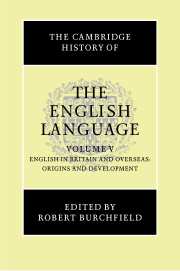Crossref Citations
This Book has been
cited by the following publications. This list is generated based on data provided by Crossref.
Kayman, Martin A.
1997.
On Difference and Difficulty: Theorizing English in Europe.
European Journal of English Studies,
Vol. 1,
Issue. 1,
p.
10.
Lass, Roger
2000.
The Cambridge History of the English Language.
Görlach, Manfred
2000.
The Cambridge History of the English Language.
p.
459.
McArthur, Tom
2001.
World English and world Englishes: Trends, tensions, varieties, and standards.
Language Teaching,
Vol. 34,
Issue. 1,
p.
1.
Bhatt, Rakesh M.
2001.
World Englishes.
Annual Review of Anthropology,
Vol. 30,
Issue. 1,
p.
527.
Crystal, David
2003.
English as a Global Language.
Hickey, Raymond
2003.
Motives for Language Change.
p.
213.
2004.
New Zealand English.
p.
326.
2004.
New Zealand English.
p.
287.
Gordon, Elizabeth
Campbell, Lyle
Hay, Jennifer
Maclagan, Margaret
Sudbury, Andrea
and
Trudgill, Peter
2004.
New Zealand English.
2004.
New Zealand English.
p.
339.
2004.
New Zealand English.
p.
296.
2004.
New Zealand English.
p.
310.
2004.
New Zealand English.
p.
100.
2004.
New Zealand English.
p.
259.
2004.
New Zealand English.
p.
1.
2004.
New Zealand English.
p.
6.
2004.
New Zealand English.
p.
334.
2004.
New Zealand English.
p.
215.
2004.
New Zealand English.
p.
85.



